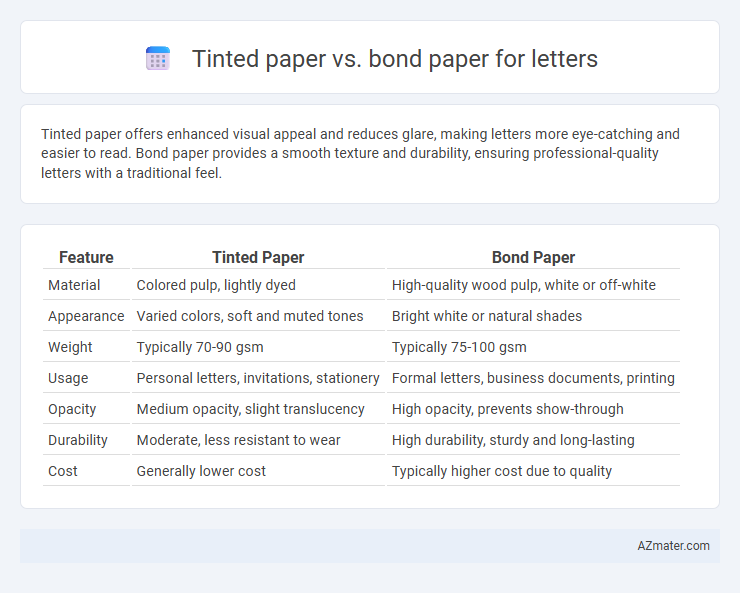Tinted paper offers enhanced visual appeal and reduces glare, making letters more eye-catching and easier to read. Bond paper provides a smooth texture and durability, ensuring professional-quality letters with a traditional feel.
Table of Comparison
| Feature | Tinted Paper | Bond Paper |
|---|---|---|
| Material | Colored pulp, lightly dyed | High-quality wood pulp, white or off-white |
| Appearance | Varied colors, soft and muted tones | Bright white or natural shades |
| Weight | Typically 70-90 gsm | Typically 75-100 gsm |
| Usage | Personal letters, invitations, stationery | Formal letters, business documents, printing |
| Opacity | Medium opacity, slight translucency | High opacity, prevents show-through |
| Durability | Moderate, less resistant to wear | High durability, sturdy and long-lasting |
| Cost | Generally lower cost | Typically higher cost due to quality |
Understanding Tinted Paper: Definition and Uses
Tinted paper features a subtle coloration achieved by adding dyes during the manufacturing process, enhancing both aesthetic appeal and readability for letter writing. Common in professional and creative correspondence, tinted paper reduces glare and provides a softer background compared to standard white bond paper. Its uses range from personal letters and invitations to official documents where visual distinction reinforces brand identity or adds a formal touch.
What Is Bond Paper? Key Features and Benefits
Bond paper is a high-quality, durable writing paper commonly used for official letters and documents due to its strong fiber content and smooth texture. Key features include excellent opacity, lightweight strength, and resistance to wear and tear, making it ideal for professional correspondence and printing. Benefits of bond paper include enhanced readability, a clean, crisp appearance, and long-lasting archival quality that ensures documents remain intact over time.
Color Psychology: Impact of Tinted vs. White Bond Paper
Tinted paper influences readers' emotions and perceptions by utilizing colors that evoke specific moods, such as blue for trust and green for calmness, enhancing the effectiveness of letters in creating desired psychological impacts. White bond paper, associated with professionalism and neutrality, provides a clean, clear background ensuring maximum readability and formal tone in correspondence. Choosing tinted paper over white bond can strategically shape the recipient's response through color psychology, increasing engagement or conveying subtle messages beyond the text itself.
Printing Clarity: Tinted Paper vs. Bond Paper Performance
Tinted paper often reduces printing clarity due to its colored background, which can interfere with ink visibility and cause text to appear less sharp compared to bond paper. Bond paper, known for its high opacity and smooth surface, provides superior print contrast, ensuring clear, crisp text ideal for professional letters. When clarity and legibility are critical, bond paper consistently outperforms tinted paper in maintaining print quality.
Suitability for Official Letters: Comparing Both Papers
Tinted paper offers a distinctive and personalized appearance, but bond paper remains the most suitable choice for official letters due to its professional, clean, and formal presentation. Bond paper's high-quality texture and opacity ensure clarity and durability, meeting the standards of business communication and legal documentation. While tinted paper may be used for creative or informal correspondence, bond paper is preferred for official letters to convey credibility and professionalism.
Cost Analysis: Tinted Paper vs. Bond Paper
Tinted paper generally costs 20-30% more than standard bond paper due to specialized dyes and manufacturing processes. Bond paper, typically priced between $0.01 and $0.05 per sheet, offers a cost-effective solution for bulk letter printing without compromising quality. For businesses aiming to balance budget and aesthetics, bond paper provides significant savings, while tinted paper serves niche purposes that may justify the higher expense.
Text Readability: How Paper Choice Affects Legibility
Tinted paper can reduce glare and eye strain, enhancing text readability for extended letter reading, but may alter color perception and contrast. Bond paper offers optimal legibility with its bright white surface and smooth texture, providing sharp contrast for black ink and improving text clarity. Choosing between tinted and bond paper depends on the lighting environment and reader sensitivity to visual comfort versus contrast intensity.
Environmental Considerations: Eco-Friendliness of Each Paper
Tinted paper often contains dyes and pigments that may require more chemical processing, potentially increasing its environmental impact compared to bond paper, which is typically made from unbleached or minimally processed fibers. Bond paper is frequently produced with recycled content and can be more easily recycled, making it a more eco-friendly option for letter printing. Choosing bond paper with certifications like FSC or EPA recycled content ensures reduced deforestation and lower carbon footprint in office printing practices.
Professional Appearance: Which Paper Makes a Better Impression?
Tinted paper offers a distinctive, eye-catching professional appearance that can make letters stand out, especially in creative industries or personalized communications. Bond paper, known for its classic white or off-white finish, conveys a traditional, polished, and highly professional image preferred in corporate and formal settings. Choosing between tinted and bond paper depends on the desired impression, with bond paper generally regarded as the better choice for universally accepted professionalism and clarity.
Choosing the Right Paper: Practical Tips for Your Letters
Choosing the right paper for letters depends on the purpose and impression you want to convey. Tinted paper offers a subtle color variation that enhances readability and adds a touch of elegance, making it ideal for personal or creative correspondence, while bond paper provides a smooth, high-quality surface perfect for professional or formal letters due to its durability and crisp presentation. For practical use, consider tinted paper for informal letters where style is key, and opt for bond paper when clarity and professionalism are essential.

Infographic: Tinted paper vs Bond paper for Letter
 azmater.com
azmater.com